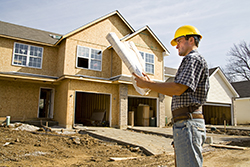Soil Best Practices: Construction
Quality landscapes start with healthy soil

Plan to restore healthy soil on construction sites.
Builders, developers, and landscapers are adopting practices that preserve and improve the soil on building sites to protect our waterways. Local governments including Seattle now require it.
Advantages to builders, consumers, and the environment include: more marketable buildings with healthier landscapes, better erosion control, easier planting, easier long-term maintenance with less water and chemical needs, and reduced stormwater runoff with better water quality for salmon, wildlife, and people too.
Soil best practices during construction:
- Retain and protect native topsoil & vegetation where practical.
- Restore disturbed soils, to healthy soil function, by:
- Stockpiling & reusing good quality site soil, or
- Tilling 2-3" of compost into site soils, or
- Bringing in 8" of compost- amended topsoil.
- Loosen compacted subsoil, if needed, by ripping to 12" depth.
- Mulch landscape beds after planting.
- Protect restored soils from erosion or re-compaction by heavy equipment.
Related Articles
Soils for Salmon Report (pdf) Integrating Stormwater, Water Supply, and Solid Waste Issues in New Development and Existing Landscapes – an illustrated report on the regional Soils for Salmon initiative.
BioCycle Journal articles: Soils for Salmon Update (2007) and Green Infrastructure (2012).